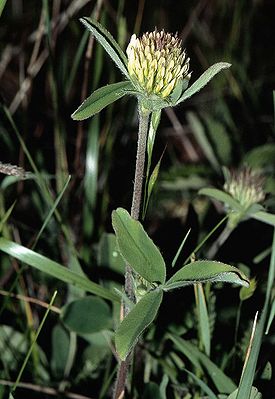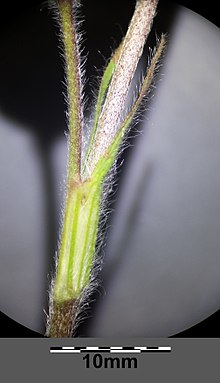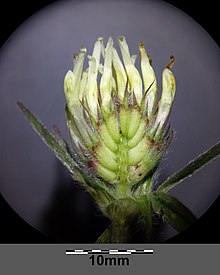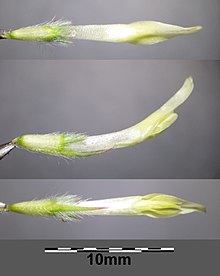Pale yellow clover
| Pale yellow clover | ||||||||||||
|---|---|---|---|---|---|---|---|---|---|---|---|---|

Pale yellow clover ( Trifolium ochroleucon ) |
||||||||||||
| Systematics | ||||||||||||
|
||||||||||||
| Scientific name | ||||||||||||
| Trifolium ochroleucon | ||||||||||||
| Huds. |
The pale yellow clover ( Trifolium ochroleucon ) is a plant species within the subfamily of the butterflies (Faboideae). It belongs to the sub-section Ochroleuca from the section Trifolium in the genus Klee ( Trifolium ).
description

Appearance and leaf
The pale yellow clover grows as a perennial herbaceous plant . It has a creeping or sloping, rather thin, often branched "rootstock". The stem is usually upright, only ascending at the base, usually 20 to 50 cm high, with three to five internodes , rather thin and protruding with shaggy hair.
The alternate leaves are arranged in a petiole and a leaf blade. The petioles are hairy, thin, the lower ones long, the uppermost very short. The leaf blade is pinnate in three parts. The leaflets are elongated-elliptical to lanceolate, usually 1.5 to 3 cm long and 5 to 8 mm wide, blunt to marginalized, with many weak, fairly straight, somewhat networked nerves, almost entire, of a fresh green color and silky hair on both sides . The stipules are rather small, lanceolate, the lower ones well connected to the petiole, light brownish with green veins and densely shaggy hairy. The free part is herbaceous, sub-like and ciliate.
Inflorescence and flower
The flowering time is in the months of June and July. The head-shaped inflorescences are usually solitary, ovoid to short cylindrical, about 1.5 to 3 cm long, more or less raised above the two uppermost, almost opposite, unevenly short stalked leaves and have a stalk about 0.5 cm long. The flowers are sessile, without bracts and curved erect.
The hermaphrodite flowers are about 1.5 cm long, zygomorphic and five-fold with a double flower envelope . The calyx-tube is funnel-shaped, ten-nerved, stiffly haired and has a throat closed by a bulge. The calyx teeth are lanceolate, three-veined, ciliate, green and rigid at the time of fruiting. The lowest is longer, the upper shorter than the calyx tube. The crown has the typical shape of the butterfly flower, is much longer than the calyx, yellowish white, then fades to reddish brown and soon sloping. The flag is lanceolate, curved upwards, twice as long as the wings and the shuttle .
Fruit and seeds
The legumes are egg-shaped and have a popping, cartilaginous lid. The brownish seeds are relatively small and oval.
Chromosome number
The number of chromosomes is 2n = 16.
Occurrence
Trifolium ochroleucon is a European-West Asian and a sub-Mediterranean-subatlantic floral element . The pale yellow clover has its main distribution in southern Europe and the Mediterranean area . To the north it occurs as far as Great Britain and northern France . Widespread further east in Germany, southern Poland , southern Russia , the Caucasus , Asia Minor , Algeria and Morocco . In the Mediterranean region it only thrives in montane locations.
The pale yellow clover is quite rare in Central Europe. It is missing, with the exception of a few locations in the southern Eifel , in the Rheingau and between the Moselle and Saar and north of the Main; in the Keuper areas south of the Main, in the Jura , in Burgenland in Lower and Upper Austria, and in northern and western Switzerland , it occurs rarely, but there it usually forms smaller populations at its locations. In Bavaria the pale yellow clover occurs only very scattered in the Franconian Alb and is very rare overall (for example in north-western Bavaria). In southern Europe, the pale yellow clover is said to be grown occasionally as a forest pasture plant.
In Central Europe, the pale yellow clover inhabits moderately dry to moist rough meadows , alternately dry lawns, forest clearings , light forest areas, light deciduous forests, roadsides and dry locations in flat moors . It occurs particularly in the montane altitude range . In Central Europe it occurs mainly in societies of the Mesobromion association, is a weak character species of the order Brometalia and also occurs in societies of the order Origanetalia.
The pale yellow clover thrives best on at times moist, at times dry, loamy or clayey soils that should be poor in lime, rich in humus and fairly deep.
Danger
In the Red List of Endangered Plant Species in Germany, the pale yellow clover was listed in Category 3 in 1996, i.e. it was rated as endangered.
Taxonomy
William Hudson called this species Trifolium ochroleucon in the first edition of his Flora anglica from 1762 . In the second and third editions he latinized that in Trifolium ochroleucum . But since nothing speaks against the original spelling, the species must correctly be called Trifolium ochroleucon .
literature
- Gustav Hegi, H. Gams, H. Marzell: Illustrated flora of Central Europe. Pteridophyta, Spermatophyta . 2nd Edition. Volume IV. Part 3: Angiospermae: Dicotyledones 2 (5) (Leguminosae - Tropaeolaceae) . Carl Hanser and Paul Parey, Munich and Berlin / Hamburg 1964, ISBN 3-489-70020-1 (unchanged reprint from 1923-1924 with addendum).
- Konrad von Weihe (ed.): Illustrated flora. Germany and neighboring areas. Vascular cryptogams and flowering plants . Founded by August Garcke. 23rd edition. Paul Parey, Berlin / Hamburg 1972, ISBN 3-489-68034-0 .
- Oskar Sebald, Siegmund Seybold, Georg Philippi (Hrsg.): The fern and flowering plants of Baden-Württemberg . 2nd expanded edition. tape 2 : Special part (Spermatophyta, subclass Dilleniidae): Hypericaceae to Primulaceae . Eugen Ulmer, Stuttgart (Hohenheim) 1993, ISBN 3-8001-3323-7 .
- Wolfgang Adler, Karl Oswald, Raimund Fischer: Excursion flora of Austria . Ed .: Manfred A. Fischer. Eugen Ulmer, Stuttgart / Vienna 1994, ISBN 3-8001-3461-6 .
- Christian Heitz: School and excursion flora for Switzerland. Taking into account the border areas. Identification book for wild growing vascular plants . Founded by August Binz. 18th completely revised and expanded edition. Schwabe & Co., Basel 1986, ISBN 3-7965-0832-4 .
- Erich Oberdorfer : Plant-sociological excursion flora . With the collaboration of Theo Müller. 6th, revised and expanded edition. Eugen Ulmer, Stuttgart (Hohenheim) 1990, ISBN 3-8001-3454-3 .
Individual evidence
- ↑ a b Trifolium ochroleucon Huds., Pale yellow clover. In: FloraWeb.de.
- ↑ a b Erich Oberdorfer : Plant-sociological excursion flora for Germany and neighboring areas . 8th edition. Verlag Eugen Ulmer, Stuttgart 2001, ISBN 3-8001-3131-5 . Page 597.
- ↑ a b c d Dietmar Aichele, Heinz-Werner Schwegler: The flowering plants of Central Europe . 2nd Edition. tape 2 : Yew family to butterfly family . Franckh-Kosmos, Stuttgart 2000, ISBN 3-440-08048-X .
- ^ Trifolium ochroleucon in the Germplasm Resources Information Network (GRIN), USDA , ARS , National Genetic Resources Program. National Germplasm Resources Laboratory, Beltsville, Maryland. Retrieved March 21, 2017.
Web links
- Pale yellow clover. In: FloraWeb.de.
- Pale yellow clover . In: BiolFlor, the database of biological-ecological characteristics of the flora of Germany.
- Trifolium ochroleucon Huds. In: Info Flora , the national data and information center for Swiss flora . Retrieved November 18, 2015.
- Profile and distribution map for Bavaria . In: Botanical Information Hub of Bavaria .
- Thomas Meyer: Data sheet with identification key and photos at Flora-de: Flora von Deutschland (old name of the website: Flowers in Swabia )




